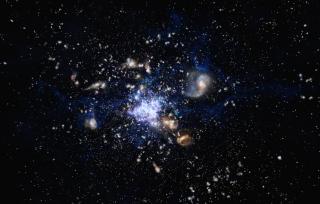Bibcode
Vega-Ferrero, J.; Domínguez Sánchez, H.; Bernardi, M.; Huertas-Company, M.; Morgan, R.; Margalef, B.; Aguena, M.; Allam, S.; Annis, J.; Avila, S.; Bacon, D.; Bertin, E.; Brooks, D.; Carnero Rosell, A.; Carrasco Kind, M.; Carretero, J.; Choi, A.; Conselice, C.; Costanzi, M.; da Costa, L. N.; Pereira, M. E. S.; De Vicente, J.; Desai, S.; Ferrero, I.; Fosalba, P.; Frieman, J.; García-Bellido, J.; Gruen, D.; Gruendl, R. A.; Gschwend, J.; Gutierrez, G.; Hartley, W. G.; Hinton, S. R.; Hollowood, D. L.; Honscheid, K.; Hoyle, B.; Jarvis, M.; Kim, A. G.; Kuehn, K.; Kuropatkin, N.; Lima, M.; Maia, M. A. G.; Menanteau, F.; Miquel, R.; Ogando, R. L. C.; Palmese, A.; Paz-Chinchón, F.; Plazas, A. A.; Romer, A. K.; Sanchez, E.; Scarpine, V.; Schubnell, M.; Serrano, S.; Sevilla-Noarbe, I.; Smith, M.; Suchyta, E.; Swanson, M. E. C.; Tarle, G.; Tarsitano, F.; To, C.; Tucker, D. L.; Varga, T. N.; Wilkinson, R. D.
Bibliographical reference
Monthly Notices of the Royal Astronomical Society
Advertised on:
9
2021
Citations
47
Refereed citations
43
Description
We present morphological classifications of ~27 million galaxies from the Dark Energy Survey (DES) Data Release 1 (DR1) using a supervised deep learning algorithm. The classification scheme separates: (a) early-type galaxies (ETGs) from late-type galaxies (LTGs); and (b) face-on galaxies from edge-on. Our convolutional neural networks (CNNs) are trained on a small subset of DES objects with previously known classifications. These typically have mr ≲ 17.7 mag; we model fainter objects to mr < 21.5 mag by simulating what the brighter objects with well-determined classifications would look like if they were at higher redshifts. The CNNs reach 97 per cent accuracy to mr < 21.5 on their training sets, suggesting that they are able to recover features more accurately than the human eye. We then used the trained CNNs to classify the vast majority of the other DES images. The final catalogue comprises five independent CNN predictions for each classification scheme, helping to determine if the CNN predictions are robust or not. We obtain secure classifications for ~87 per cent and 73 per cent of the catalogue for the ETG versus LTG and edge-on versus face-on models, respectively. Combining the two classifications (a) and (b) helps to increase the purity of the ETG sample and to identify edge-on lenticular galaxies (as ETGs with high ellipticity). Where a comparison is possible, our classifications correlate very well with Sérsic index (n), ellipticity (ϵ), and spectral type, even for the fainter galaxies. This is the largest multiband catalogue of automated galaxy morphologies to date.
Related projects

Traces of Galaxy Formation: Stellar populations, Dynamics and Morphology
We are a large, diverse, and very active research group aiming to provide a comprehensive picture for the formation of galaxies in the Universe. Rooted in detailed stellar population analysis, we are constantly exploring and developing new tools and ideas to understand how galaxies came to be what we now observe.
Anna
Ferré Mateu

Molecular Gas and Dust in Galaxies Across Cosmic Time
Two of the most fundamental questions in astrophysics are the conversion of molecular gas into stars and how this physical process is a function of environments on all scales, ranging from planetary systems, stellar clusters, galaxies to galaxy clusters. The main goal of this internal project is to get insight into the formation and evolution of
Helmut
Dannerbauer